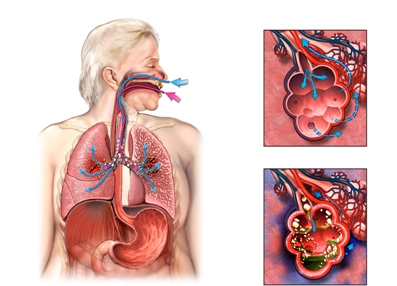Pneumonia
Description pneumonia
Pneumonia – lung infection. It affects the lower respiratory tract, which include the Bronchioles and alveoli (the air sacs in the lungs).

Causes of Pneumonia
There are three the main reasons for:
- Bacterial pneumonia, caused by bacteria – most often streptococcal pneumonia;
- Virus pneumonia, caused by viruses;
- Atypical bacterial pneumonia, that can lead to serious and potentially fatal inflammation of the lungs.
Other causes of pneumonia include:
- Fungal infections – mainly in people, AIDS patients.
Pneumonia is sometimes described by place, where you purchased it:
- Community-acquired pneumonia – occurs in a group (eg, at school, at work, gym);
- Hospital-acquired pneumonia – occurs during hospitalization in hospital;
- Can be very dangerous, especially for patients with lung diseases;
- Aspiration pneumonia – there, When foreign substances (often the contents of the stomach) into the lungs.

Risk factors
Factors, that increase the likelihood of contracting pneumonia include:
- Age: 65 and older;
- Flu or other respiratory illness;
- Chronic diseases, such as heart disease or lung;
- Stroke (aspiration pneumonia can occur due to problems with swallowing);
- Weakened immune system due to AIDS or chemotherapy;
- Chronic bronchitis;
- Malnutrition;
- Pregnancy;
- pneumonia often occurs in infants and young children;
- Substance abuse;
- Smoking;
- Prolonged exposure to certain chemicals (eg, work in construction or agriculture).
Symptoms of pneumonia
Symptoms may vary depending on the type of pneumonia.
| Bacterial pneumonia | Virus pneumonia | SARS |
| Fever | Fever | Fever, often mild |
| Chills | Chills | Chills |
| Coughing green, yellow, or reddish mucus | Dry cough | Cough; may be made from time to time strong; produces white mucus |
| Pain in the chest | Headache | There may be nausea or vomiting |
| Profuse sweating | Muscle weakness | Weakness |
| Bluish lips and nails due to the decrease of oxygen in the blood | Bluish lips and nails due to the decrease of oxygen in the blood | |
| Confusion | Weakness |
Diagnosis of pneumonia
The doctor asks about the symptoms and medical history, and performs a physical exam. Diagnosis is based on symptoms and chest listening stethoscope. Tests may include the following:
- Chest X-ray – to take pictures of structures inside the body, in this case the chest;
- CT scan – type of X-ray inspection, to make pictures of structures inside the chest;
- Blood tests;
- Bronchoscopy – examination of the upper respiratory tract;
- Testing of phlegm and mucus, released when coughing;
- Pulse oximetry – measuring the amount of oxygen in the blood;
- Analysis of gases, dissolved in arterial blood – oxygen, carbon dioxide and nitrogen.
Treatment of pneumonia
Treatment of pneumonia depends on the:
- Type of pneumonia;
- The severity of symptoms;
- Other factors.
Treatment approaches include:
- For bacterial pneumonia – antibiotics;
- For viral pneumonia – It may be prescribed antiviral drugs for small children and people with weakened immune systems;
- Attention: Antibiotics are ineffective for treating viral pneumonia.
- SARS – antibiotics.
It is very important to take medications, prescribed by a doctor. Early discontinuation of treatment may lead to relapse.
General rules for treatment of pneumonia include:
- Recreation and drinking large amounts of fluids;
- Healthy eating (consuming large amounts of fruit and vegetables). It is recommended to take vitamin c – to 1000 mg per day;
- Medications to reduce fever, pain and cough;
- Hospitalization (in severe cases).
Prevention of pneumonia
Some vaccines can prevent pneumonia:
- Vaccination against influenza to persons at high risk of respiratory infections, especially in the elderly (Pneumonia may be a complication of the flu);
- Pneumococcal vaccine – Common recommendations include:
- Pneumococcal conjugate vaccine (PKV) – for children;
- Pneumococcal polysaccharide vaccine (PPSV) – for adults aged 65 and older and for young people, that belong to the high risk of infection.
Other preventive measures include:
- Avoid smoking. Smoke weakens the resistance to lung infections;
- Avoiding close contact with people, who are sick with cold or flu;
- You need to wash your hands after contact with infected people;
- The use of protective equipment (mask, respirator, gas mask) at work, that can cause pneumonia;
- Intake of healthy foods. Particular attention should be paid to enter the body of sufficient vitamin c and zinc;
- It is necessary to fully relax;
- Need to do regular physical exercise.
